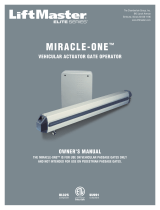
VIKING TECHNICAL SUPPORT 1.800.908.0884
4
CONTROL BOARD REFERENCES:
1.
HEAT SINK - SLAVE MODULE
secures the control board and dissipates heat.
2.
SLAVE MODULE POWER HARNESS CONNECTOR
provides power to the Slave Module. pg 23
3.
FUSE HOLDER - 15 AMP
for the Slave motor circuit.
4.
“FAIL SAFE/SECURE” Jumper - SLAVE MODULE
power failure option. pg 26
5.
M/S COMM CABLE CONNECTION - SLAVE MODULE
master/slave (dual) gate applications. pg 23
6.
STATUS LEDs - SLAVE MODULE
provides diagnostic information.
7.
SLAVE MOTOR CONNECTION
provides power to the Slave motor. pg 23
8.
HEAT SINK - MASTER/SINGLE
secures the control board and dissipates heat.
9.
FUSE HOLDER - 4 AMP
for the charging circuit.
10.
FUSE HOLDER - 15 AMP
for the Master motor circuit.
11.
LIMIT SETUP BUTTONS
available for future developments.
12.
LCD DIAGNOSTICS DISPLAY
provides error messages, diagnostics settings
and operator status information. pg 38-40
13.
M/S COMM CABLE CONNECTION - MASTER BOARD
master/slave (dual) gate applications. pg 23
14.
“DIAGNOSE” LED
informs that errors have been detected and
available on LCD Display. pg 38-40
15.
“DIAGNOSE” Button
allows you to navigate through the
Diagnostics LCD Display. pg 38-40
16.
FEATURE ACTIVATION PIN HEADERS
activate features by placing a jumper onto the
pin headers. pg 26
17.
“AUX. PWR” Terminal Block
used for solar applications & in-motion
warning devices. pg 21, 26
18.
ON-BOARD 3 BUTTON STATION
controls the gate during set up.
19.
“Siren” Terminal Block
Vikings UL Siren is connected here. pg 12, 27
20.
CONTROL BOARD MOUNTING HOLES
secures and grounds the control board.
21.
POWER HARNESS CONNECTOR
provides power to the control board. pg 20
22.
MASTER or SINGLE MOTOR CONNECTION
provides power to the motor. pg 22
23.
“FAIL SAFE/SECURE” Jumper
power failure option. pg 26
24.
FEATURE ACTIVATION TRIM POTS
activate and set features. pg 25
25.
“EPS1” CONNECTOR
available for future developments
26.
“EPS2” CONNECTOR
available for future developments
27.
“EMI” BOARD CONNECTOR
monitors the high voltage power supply.
28.
“CHECK MOTOR” Status LED
indicates motor power status. pg 36
29.
“BATTERY LOW” Status LED
indicates battery power status. pg 36
30.
“POWER” Status LED
control board power status. pg 20, 36
31.
“MAGNETIC LOCK Relay” Status LED
status of this on-board relay. pg 34, 36
32.
“MAGNETIC LOCK Relay” Terminal Block
connect electric locks here. pg 34, 36
33.
INPUT STATUS LEDs
indicates input status. pg 36-37
34.
ACCESS CONTROL TERMINAL BLOCKS
accessory connections. pg 29-32, 42-44
























